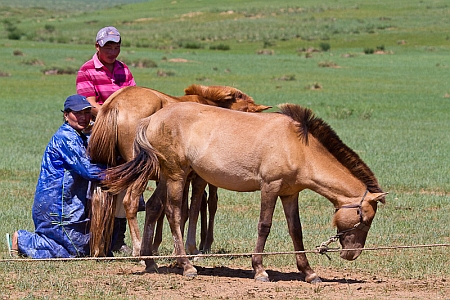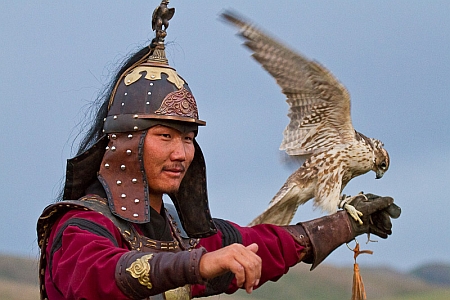![]()
August 02 - August 18, 2011
M O N G O L I A
Gobi , Altay Mountains & Hovds Gull Tour
Group Journal Day 01
Submitted by Sue West
KARAKOURUM - ORHUN MONUMENT
Aug.02, 2011 Tuesday
Itinerary: Leave Ulaan Bataar at 07:30 AM. Drive 785 Km west of the capital to Karakourum. Visit Khshuu Tsaidam museum. Overnight at Munkhu Tenger in Karakourum Valley.
On the first day of the tour, we headed out under the famous Mongolian blue skies. With nine travelers, tour leaders and our driver, we passed much just on our way out of Ulaanbaatar. On our way over the Peace Bridge and the Tuul River, we looked down to see a section of the Trans-Siberian Railway and up to view Bogd Kahn Mountain, the first designated protected area in the world. We then passed by the Bogd Khan Winter Palace, as well as factories producing carpets, alcohol, juice, and dairy products. Coal and petroleum plants were in the distance, though we learned that Mongolia has no refineries and Japan is interested in building some, which would relieve Mongolia’s current dependence on Russia. Closer at hand, houses and gers shared land within fenced areas, the homes’ brightly colored roofs coming from Korea. Such shared areas are more economical for families, with satellite dishes and solar panels being quite common.



A warrior of Chingizz Khan, the shaman ovoo and blessed Buddhist scarf.
What more could we ask to be Mongolian.
Our First encounter with a spectacular all Mongolia cultural site was an ovoo by the main highway. The blue ribbons were wrapped around a high pole designating site to be sacred. Like all the Mongolians do, we too stopped at the ovoo to walk around it - clock wise - three times to get our wishes come true. It sis not take long for our group to get in the spiritual. As we were walking around the ovoo, first Jim noticed a little statue of a worrier stuck in between the piles of the blue ribbon offerings. Probably some one was praying to be as courageous as the warrior. The cotton candy like clouds were setting a wonderful back ground for the stupa which was next to the ovoo. We later learned that those who did not want the minors or developers take their land the would put up the stupas and ovoos to claim the land to be sacred. For those of us who were looking for a true Mongolian photo opportunity, we thought we were in heaven.




As we passed from the city to the steppe, herds of sheep, goats, and horses were common in the vast landscape. A herd of 1000 livestock is the average for most families which rely on them for food, clothing, and housing. Some crops grown locally include wheat, potatoes, barley, beets, cucumbers, tomatoes, and parsley. As we drove, we stopped often to take photos, and at one point we watched herders lasso animals, and drive horses and goats across a river. The big slow running river was very inviting for the animals While some horses were being milked , the others were either washing in the river or taking a siesta. we sent the van to the other side of the bridge to be able to get full shot of the activity going on under and over the bridge. The woman who was milking the horse called a baby horse next to the mother. poor mother horse thought she was letting her milk run for her baby, but the milk was captured in the buckets.
The horses tend to cuddle together, It is sometimes difficult to tell whose head belongs to whose tail. One little horse chose to be alone and took a nice nap after his bath in the river.
The nomad children were quite indifferent to our presence. They did politely smile but kept doing their own business. The colors of the horses varied from pitch dark to albino. there were every shade of brown. Boloro told us that each shade of a color has a different name for the horses













The gers were using solar panels for
electricity. Horse and camel dung was collected neatly in the baskets.
With their motorcycles, 4 wheel drive cars, the people looked like they
were going back and forth in a time tunnel.








 fter
a lunch stop at a ger camp, we went to the “strip between the dunes,” a
sand area part of the North Gobi. But the highlight of the afternoon was
the visit to the Orkhon Valley, the Karakorum area where Chenggis Khan
held court. Excavations in the area have revealed several levels of
artifacts, the most interesting at the museum where two stone pillars are
now housed. One is dedicated to the Bilge Khan who ruled the area from
683-734, and the other to Kul-Tegin who succeeded him from 684-731. The
kingdom was a Turkish khaganate, a pre-Mongol empire, and the pillars are
the oldest record of Turkish runic language in the world.
Orhun Monument, The earliest Turkish monument
written by Gultekin Han and Bilge Kaan.
The Turkish Government had built a modern museum around the old Turkish
relics and monuments
fter
a lunch stop at a ger camp, we went to the “strip between the dunes,” a
sand area part of the North Gobi. But the highlight of the afternoon was
the visit to the Orkhon Valley, the Karakorum area where Chenggis Khan
held court. Excavations in the area have revealed several levels of
artifacts, the most interesting at the museum where two stone pillars are
now housed. One is dedicated to the Bilge Khan who ruled the area from
683-734, and the other to Kul-Tegin who succeeded him from 684-731. The
kingdom was a Turkish khaganate, a pre-Mongol empire, and the pillars are
the oldest record of Turkish runic language in the world.
Orhun Monument, The earliest Turkish monument
written by Gultekin Han and Bilge Kaan.
The Turkish Government had built a modern museum around the old Turkish
relics and monuments




